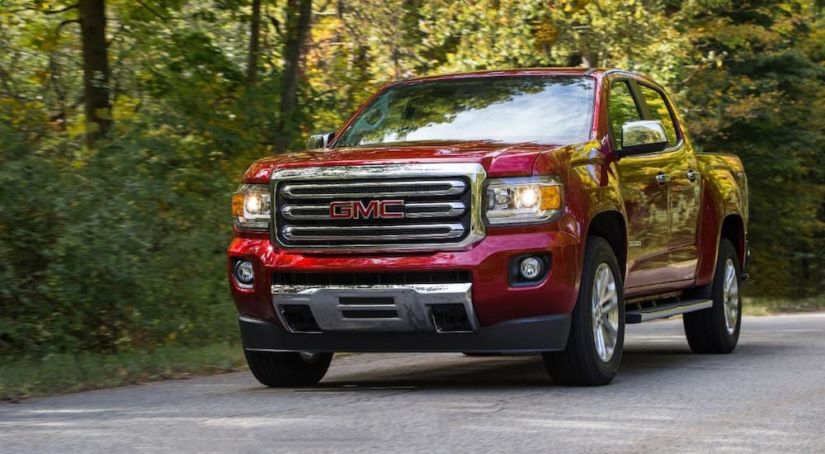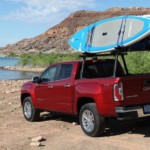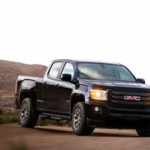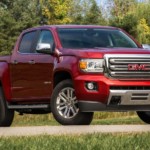GMC’s Canyon and Chevy’s Colorado admittedly share some similarities, as they are both midsize pickups manufactured by General Motors. These trucks share the same powertrain, among other mechanical components as is expected. But while they may be evenly matched under the hood, there are several differences between the two. Both are capable vehicles for truck buyers who might have slightly different needs. The Canyon feels a bit more upscale while the Chevy isn’t afraid to get down and dirty by playing in the mud. If you’re considering a new midsize truck, you’ve probably narrowed down your choices between the 2019 GMC Canyon vs 2019 Chevy Colorado. Let’s take a closer look at their more distinct personalities.
Under the Hood
GMC Canyon: Three engine options are available for the Canyon, starting with the base model 2WD work truck and its 2.5L four-cylinder generating 200 horsepower. Next up is a 3.6L direct-injection V6 which pushes out 308 horsepower. At the top of the pile is a 2.8L turbocharged diesel offering up 181 horsepower and a healthy 369 lb-ft of torque. Depending on the engine chosen, they are paired with either a six or eight-speed automatic transmission.
Chevy Colorado: As mentioned at the top of this article, both trucks offer the same power train options. The only difference on the Colorado is a boost to a whopping 369 lb-ft of torque with the V6 engine.
Off-Road Performance
GMC Canyon: While perfectly capable once it leaves the comfort of a paved road, GMC’s offering is directed more towards the driver who’d rather not bash over roots and rocks on the weekend. The Canyon also comes in an all-terrain model which has a locking rear differential and off-road-tuned suspension. The all-terrain X model adds on beefier tires as well.
Chevy Colorado: For drivers who really want to shake it up off-road, the Colorado will get your adrenaline going and your heart pumping. The Z71 package includes extras like a locking rear differential, hill descent control, and tuned suspension. The ZR2 model includes suspension dampeners just case you get some air, accidental or not. Ground clearance is improved, plus an increased approach angle of 30 degrees to make climbing out of those stream beds easier. The more extreme AEV Bison adds steel skid plates to protect the underside of the truck from damage due to obstacles.
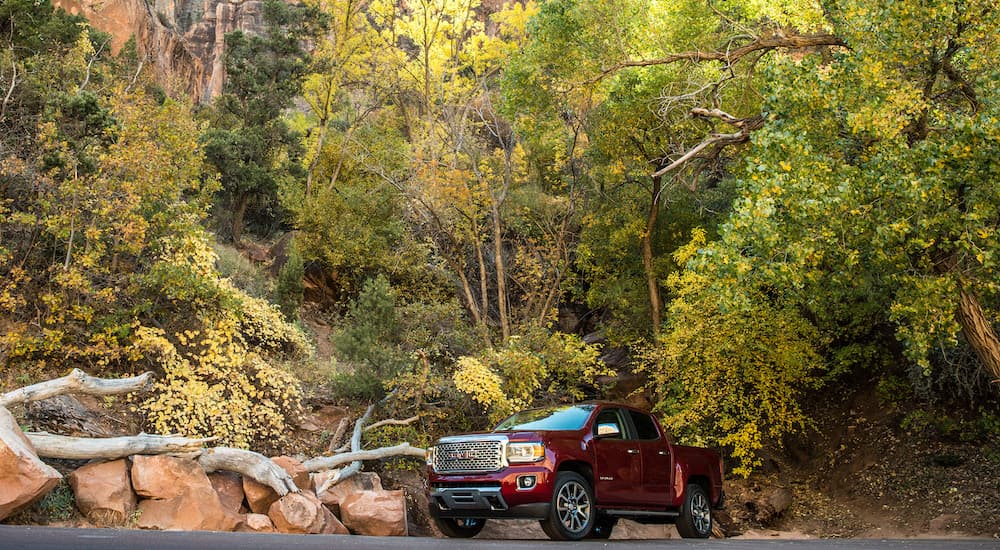
Tech and Safety Features
GMC Canyon: Innovative systems like Forwarding Collision Alert, Rear Park Assist, Teen Driver, and Lane Departure Warning, to name a few, come standard on the Denali trim level. Both the Colorado and the Canyon come with an expansive suite of airbags to help protect occupants in a collision from any angle.
Chevy Colorado: Chevy’s offering includes a large touchscreen display, backup camera, and Apple CarPlay integration. While built-in 4G LTE WiFi keeps both drivers and passengers connected while on the go. The Colorado always comes with excellent safety features that you can find standard even on their lowest trim. HD Rear Vision Camera, Electronic Traction Control, and of course GM’s award-winning On-Star system. Of course, you can add more safety features to any trim you decide on.
Cargo and Cabin Space
GMC Canyon: With both trucks, the interior dimensions are pretty much identical, so the numbers below apply to both vehicles. Front seat passengers have plenty of room to stretch out with 45 inches of legroom. Rear seat occupants don’t quite get the spacious accommodations like those in front when it comes to legroom, as the room drops off to 35.8 inches for the Crew Cab and 28.6 for the Extended.
Chevy Colorado: Both trucks come in three different body styles, with the Extended Cab models offering a 6’2″ bed, while the Crew Cab comes in two options – 5’2″ or 6’2″. Since the Crew Cab has a larger cabin, this makes for an overall larger vehicle, on par with the king-sized Suburban.
Towing and Payload Capacity
GMC Canyon: The 3.6L V6 shared by both trucks is no slouch when it comes to muscle. It can tow up to a massive 7,000 lbs. and carry loads up to 1,575 lbs. When considering these numbers, don’t forget to take passengers into account as well. Even the low-end 200 horsepower engine is perfectly capable of towing up to 3,500 lbs. and you can load up to 1,450 lbs. respectively.
Chevy Colorado: The monster option here is the 2.8L turbocharged diesel, which can haul a maximum of 7,700 lbs. when properly equipped. And with a payload limit of 1,500 lbs. there’s plenty of capacity to haul all the building materials you need.
Fuel Economy
GMC Canyon: Starting with the base model 2WD version, you’ll get 26 mpg on the highway while the V6 option drops that number down slightly to 25 mpg. Four-wheel drive comes in around 24 mpg. For city driving, both models provide on average of 20 mpg.
Chevy Colorado: For both trucks, the diesel is rated better in terms of fuel economy as expected – especially in the 2WD version – with a maximum driving range of about 630 miles. That equates to around 30 mpg on the highway. In city driving situations, mileage ratings come in about the same as the Canyon. However, going with the ZR2 models drops fuel economy to 16/18 for the V6 and 18/22 for the diesel, due mostly in part to the larger off-road tires.
Styling and Exterior Appearance
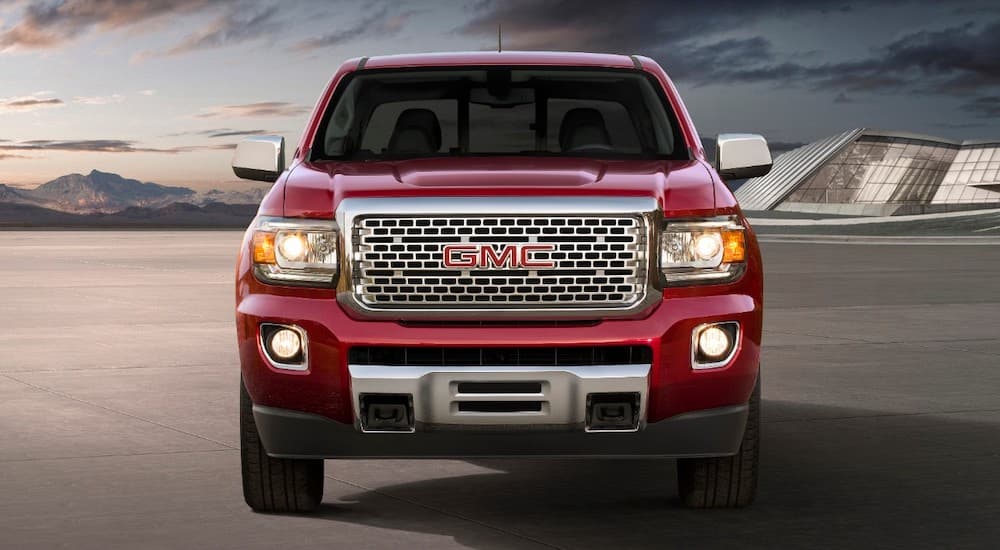
GMC Canyon: GMC markets its trucks as vehicles for doing work during the day, which also clean up well for heading out during the evening. Chrome accents abound on the Canyon with most trim levels, giving it a sparkle that will be sure to turn heads. The all-terrain scales this back and the Denali features a distinctive grille and exterior trim accents. No matter which trim level you go with, you’ll be driving a sharp-looking truck.
Chevy Colorado: Chevy’s offering serves up rugged good looks that complement its down and dirty utility, which is aided by the right proportions and an attractive array of color schemes. The ZR2 and Bison models assume a more imposing stance thanks to their larger tires.
Sizing Up These Siblings
No matter which one of these trucks you might have your eye on, the 2019 GMC Canyon and the 2019 Chevy Colorado are very similar. But as we’ve seen above, also have their differences which make them unique in some respects. They no longer look like identical twins as they did in earlier iterations. The Canyon has a bit more sophistication and flair, which makes it equally at home in the woods or in the parking lot of an upscale restaurant. The Colorado isn’t afraid to go where some other trucks might not tread. The exterior appearances also give each vehicle its own distinct look. In most areas, both the Canyon and Colorado are alike in most major areas such as safety, technology, fuel economy, and cabin/cargo capacity. So, drivers, you might have a bit of a difficult decision to make when carefully considering each of these trucks. The choice is ultimately going to come down to which one works best for what you need it for, and what kind of deal you can get.
